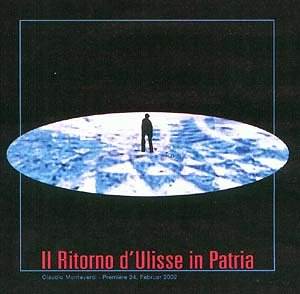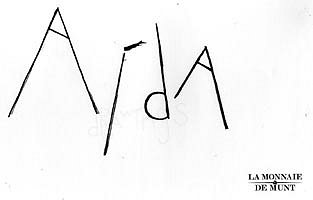MONTEVERDI IL RITORNO D'ULISSE IN PATRIA Klaus Michael Grüber/Nikolaus Harnoncourt Premiere 24 February 2002 Opernhaus, Zurich
Rolf LIEBERMANN MEDEA Jorge Lavalli/ Daniel Klajner 21 February 2002 Opera Bastille, Paris
VERDI AIDA Robert Wilson/Antonio Pappano 17 February 2002 La Monnaie, BrusselsEasy travel across the Channel and by Europe's renowned train services makes opera fancying for the British abroad affordable and pleasurable. With a favourable exchange rate, seat prices are generally lower than in UK. Three operas set in the ancient world seen in Europe during February provoked thoughts about the different approaches to operatic production now current.
MONTEVERDI IL RITORNO D'ULISSE IN PATRIA Nikolaus Harnoncourt/Klaus Michael Grüber Opernhaus, Zurich
The earliest of them was the 72 year old Monteverdi's Il Ritorno d'Ulisse in Patria of 1640. Nikolaus Harnoncourt, who first directed it as long ago as 1967, considers the radical innovations in new opera of the 1600s to have been as important and revolutionary as the early 20th C assault upon tonality.
Klaus Michael Grüber's new production (assisted by Ellen Hammer) supports Monteverdi's aim to put the human drama in the foreground and individualise characters through musical forms. The sets (Gilles Aillaud with Bernard Michel) have an apt simplicity, eschewing fussy detail and spectacular effects. The colours are cool, predominantly white, blue and black, transporting us to a modern day, rather poor Greek village. Penelope's residence is shown as a stark white wall, like a child's depiction of an oracular face, with windows and the doorway opening blacked out. The cobbled ground, which revolves to indicate distance and the passage of time, is painted blue and white, with the face of a God in the foreground. Attention is focussed and concentrated upon the protagonists. Eva Dessecker's costumes are updated and relevant, with Penelope in simple black, like the widow of twenty years she feels herself to be, and she is surrounded by village characters we could have met on holiday.The complex story of human fate at the mercy of Time, Fortune and Love is not always clarified by this staging and at times we were as confused as the principal players, some of whom are in and out of disguise. A clean-shaven Ulisse ( is deposited on the shore from a small boat, which is immediately seen to break up in the storm. Seeming confused as to who and where he is, Ulisse is soon cloaked and disguised as a bearded elder by Minerva, she herself appearing as a jaunty shepherdess. A couple of argumentative old men prove to be Jupiter and Neptune, the latter's tri-partite beard his trident. There is a reunion of father and son.
Reality becomes tenuous, with Penelope's importunate suitors become puppeteers, their gaudy puppets ridiculous, and each in turn too weak to draw what purports to be Ulisse's famous bow (echoes of the suitors in The Merchant of Venice and of Walkure). Ulisse alone does so easily, and then in pique destroys the puppets, thereby revealing his identity, which Penelope is however slow to accept. His cloak and bearded facial disguise are removed to reveal a surprisingly youthful man in a workaday pullover, not the stuff of legend. Were the legendary exploits fantasies, a case of amnesia rather than heroic deeds, we begin to wonder irreverently?
The singing of a large cast led by Dietrich Henschel, doubling as Ulisse and Human Frailty, and Vesselina Kasarova as Penelope, is generally good though a little variable. Two young lovers duet cheerfully, the lanky Roger Widmer over-keen to show off his big tenor voice at the expense of his partner Malin Hartelius. Several minor characters have the limelight for lengthy solo scenes, one of them the comic relief character Iro, a buffoon who in this production is also proprietor of the travelling puppet show. Penelope's part lies rather low to display Kasarova's characterful and dramatic mezzo to best advantage, but she conveys her grief and withdrawal from the life around her with convincing gestures and semi-stylised poses. The crucial recognition scene between husband and faithful wife was however less moving than I recall it in Pierre Audi's production at the newly opened Amsterdam Operatheater, now many years ago.
Before Monteverdi's innovations, intricate vocal lines and highly developed polyphony had obscured words until they were incomprehensible. His reforms gave back the primacy of text, and in Orfeo he restored the balance; for Ulisse , 33 years after Orfeo, he set stories of Homer, the details of which were known to cultured opera goers, so that every character was immediately recognisable. This is no longer so, therefore it is all the more important to make the words readily 'available', by whatever means.
Harnoncourt uses a fairly large orchestra with his familiar tight control, and has varied continuo instrumentations for the singers, reserving trumpets for scenes with the rather endearing Gods. The playing is tidy and idiomatic and this version accords well with our expectations. The original source is so sketchy that different versions have proliferated and will no doubt continue to do so. It is believed that the lack of printed scores reflects the advanced improvisational skills of the time, and also Monteverdi's desire to prevent unauthorised copying; for like considerations, Harnoncourt withheld the parts of his earlier realisation of Ulisse!
In Zurich, Italian is the least spoken of the Swiss languages and the Homer text in Giacomo Badoaro's libretto is often quite complex. Without full comprehension there were inevitable longeurs in what was a long evening (three hours with one interval). Monteverdi achieves lucidity by thinning the accompanying textures, but at Zurich his best endeavours are unfortunately thwarted. The vexed issue of surtitles came to the fore for us again as we watched, often quite confused despite having read the synopsis, and it was a topic of interval discussion. We met with agreement that surtitles would not have interfered with the staged drama's impact and rather would have helped substantially; people are by now used to having a choice of text languages on DVD and surtitles are increasingly provided in opera houses after earlier purist resistance, which becomes harder to sustain when the sense is so often far from clear even with opera in native language. I would rate this Ulisse as worth seeing but not meriting a substantial special journey.
ROLF LIEBERMANN MEDEA Jorge Lavalli/ Daniel Klajner Opera Bastille, Paris
Rolf Liebermann (1910-1999) was responsible for the Hamburg Opera when it was at the forefront of contemporary opera during the great years of 1959-73, and again from 1985-88. Between those spells, from 1973-1980 he was administrator-general in charge of Paris Opera. He died in Paris, having just completed Medea, the last of his five operas and it is there that it has been premiered in the German of Ursula Haas's libretto. Precisely 70 mins in duration without interval, this production by Jorge Lavalli had visually impressive moments in its deployment of the Opera Bastille's stage machinery, but it was short on emotional resonance. Credit is due to Paris Opera for mounting this out of the way recent opera as a change from the usual war-horses, and to the large audience at the Bastille who appeared well satisfied.
Graciela Galan's costumes for the black women of Colchide were fetching, though not ideally designed for the big rape scene. The white populous was depicted simplistically in white from top to toe. The various sexualities of Medea's matriarchal sect and the Greeks were depicted with coy understatement, no nudity for the pre-sacrificial fertility celebration or gang rape nor for the fairly explicit homoerotic love scene between the men which preluded Medea's revenge. It was a nice touch to depict a warm shower with dry ice, but the promised final conflagration was regrettably left to our imagination. The best image was the first with the virgin celebrants stuck up on Agostino Pace's walls before sliding down one by one on wires, which remained invisible until they moved into the action, still encumbered like Peter Pan.
The music, from gamelan (Prince of the Pagodas!) to generalised, rather soft-edged 20 C modernism, was in the safe hands of Daniel Klajner, who had conducted Medea in Berne, but unfortunately little was of a kind to linger in the memory. The chief principals and supporting soloists put across their parts manfully and womanfully to limited effect, but there were some powerful choruses and interesting orchestral interludes. The problem, as so often with contemporary opera, was with the singing line, ungrateful save for the young Creon, with whom Jason was besotted, and who had the best part. The confident Philadelphian counter tenor Lawrence Zazzo, who made his debut as Oberon at London's Royal Academy of Music, is a name to note.
VERDI AIDA Robert Wilson / Antonio Pappano February 2002 La Monnaie, Brussels
Medea was a costly production, as one has come to expect from major international opera houses, and it brought to mind, by contrast, other treatments of ancient mythology such as Birtwistle's multi-layered exploration of the Orpheus legends or, a few days earlier, the radical rethinking of the Egyptian/Ethiopian confrontation in Verdi's Aida, premiered lavishly in Cairo 1871, and now at Brussels virtually reinvented by Robert Wilson, triumphantly making it relevant to our times.
Aida is a problem opera, holding its place in the popularity stakes with its opportunities for grandiose display on the largest scale, rather than the central human drama, which has often taken second place. Wilson has blown away both the 19th C tradition of fantastical orientalist fantasies, as represented in the Scala, Milan DVD with Pavarotti (Arthaus 100 058), and dispensed with the sort of gratuitous cruelty in the exercise of power in David Pountney's sometimes incomprehensible production for Munich State Opera, which all but suffocated the music. Wilson has stripped the work to its core elements of emotional conflict and ethical choices. His pared down, but highly sophisticated, staging has created space for the music to speak on equal terms with the visual spectacle. The characters, dressed simply, move formally at a measured pace, maintaining statuesque hieratic poses and hand positions which suggest images familiar from ancient Egyptian art. I found myself comfortably accepting this alien mode of representation immediately, its strangeness a relief from the usual operatic stock gestures, gripping attention and helping to universalise the drama that passed before us, affecting rather than distancing.
This production places Aida in a defamiliarised ancient world which accentuates ever present human conundrums and conflicts. Wilson has created a stunningly beautiful stage picture for the Nile Scene. Warm earth colours indicate the desert beyond a peaceful band of water in the middle distance, the whole suffused with heavenly blue lighting, a perfect counterpoint to the human distress and tragedy unfolding. The casting was notable, the singers working as a team, never upstaging each other, holding onto high notes or exaggerating climaxes of familiar arias. Ildiko Komlosi (Amneris) made a notable debut at Brussels, substituting for the indisposed Elena Zaremba and fitting in easily with Norma Fantini (Aida), Johan Botha (Radames) and Mark S. Doss (Amonasro). Antonio Pappano elicited playing of the highest order, breathlessly intense with sobbing violins underscoring Aida's grief and quiet passages which held the audience spellbound.
This was a production which has lodged in the memory permanently and will come to mind whenever one sees Aida in the future; it is a co-production with the Royal Opera, Covent Garden and Londoners should not miss seeing it there at the earliest opportunity, when Antonio Pappano will be established as Music Director.
Peter Grahame Woolf


 Return to:
Return to: